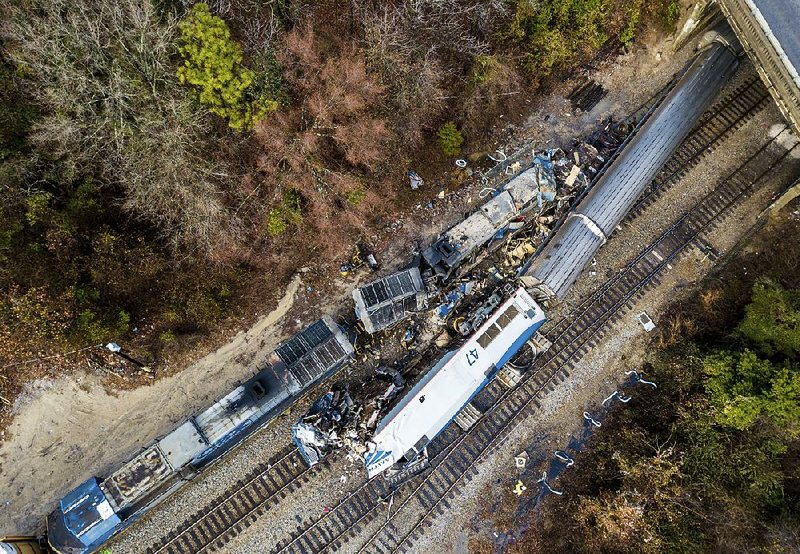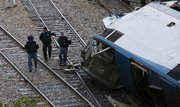CAYCE, S.C. -- An Amtrak passenger train slammed into a parked freight train in the early-morning darkness Sunday after a thrown switch sent it hurtling down a side track, authorities said. Two Amtrak crew members were killed, and more than 100 people were injured.
It was the third deadly wreck involving Amtrak in less than two months.
The Silver Star, en route from New York to Miami with nearly 150 people aboard, was going an estimated 59 mph when it struck the empty CSX train around 2:45 a.m., Gov. Henry McMaster said.
The crash happened near a switchyard about 10 miles south of Columbia where rail cars hauling automobiles are loaded and unloaded.
Robert Sumwalt, chairman of the National Transportation Safety Board, said investigators found a track switch had been set in a position that forced the Amtrak train off the main track and onto the siding.
Amtrak President Richard Anderson pointed the finger at CSX, saying the signal system along that stretch is run by the freight railroad but was down at the time of the wreck, forcing CSX dispatchers to route trains manually. The safety board said it was working to confirm that.
CSX issued a statement expressing condolences but said nothing about the cause of the accident.
The conductor and engineer aboard the Amtrak locomotive were killed. And 116 people were taken to four hospitals, according to the governor.
At least three patients were hospitalized in critical or serious condition, with nearly all the rest treated for minor injuries such as cuts, bruises and whiplash, authorities said.
Palmetto Health emergency room physician Eric Brown said so many passengers were hurt that they were transported in on two buses, and a tent that had been set up as a waiting room to keep people separate from flu patients was turned into a triage area.
"I thought that I was dead," said passenger Eric Larkin of Pamlico County, N.C., who was dazed and limping after banging his knee.
Larkin said he was on his way to Florida when he was awakened by the crash. The train was shaking and jumping, and his seat broke loose, slamming him into the row in front of him, he said.
He said he heard screams and crying all around him as he tried to get out. Other passengers were bleeding.
Passenger Derek Pettaway said he woke with a jolt when the collision happened, suffering minor whiplash. He had taken shelter with other passengers at the nearby Pine Ridge Middle School, where the American Red Cross set up a shelter. "No one was panicking. I think most people were asleep. I think people were more in shock," Pettaway said in an interview with CNN.
The locomotives of both trains were left crumpled, the Amtrak engine on its side. One car in the middle of the Amtrak train was snapped in half, forming a V off to one side of the tracks.
"It's a horrible thing to see, to understand the force involved," the governor said after touring the scene.
The White House press pool was told that President Trump had been briefed on the situation and was receiving regular updates. "My thoughts and prayers are with all of the victims involved in this mornings train collision in South Carolina," Trump wrote on Twitter. "Thank you to our incredible First Responders for the work they've done!"
Other officials also offered statements of support. Sen. Tim Scott, R-S.C., said his "prayers are with the families of those killed."
Rep. Joe Wilson, R-S.C., said those who were affected were in his thoughts. Wilson, who was on an Amtrak trail that hit a garbage truck last week, visited survivors of Sunday's crash at the middle school.
"It's surreal," Wilson said in an interview. "I identify with the passengers that you want to continue right away."
The dead were identified as engineer Michael Kempf, 54, of Savannah, Ga., and conductor Michael Cella, 36, of Orange Park, Fla.
"Any time you have anything that happens like that, you expect more fatalities. But God blessed us, and we only had the two," Lexington County Coroner Margaret Fisher said.
"We should have had a lot more casualties, but we didn't," she said.
'LIKE AN EPIDEMIC'
Sumwalt said that positive train control -- a GPS-based safety system that can automatically slow or stop trains -- could have prevented the accident.
"That's what it's designed to do," he said, referring to technology for which regulators have been pressing for decades, with mixed success.
On Wednesday, a chartered Amtrak train carrying Republican members of Congress to a retreat slammed into a garbage truck in rural Virginia, killing one person in the truck and injuring six others.
And on Dec. 18, an Amtrak train ran off the rails along a curve during its inaugural run near Tacoma, Wash., killing three people and injuring dozens. It was going nearly 80 mph, more than twice the speed limit.
With the recent string of crashes, "it's becoming almost like an epidemic for Amtrak," said Najmedin Meshkati, a University of Southern California engineering professor who has studied positive train control.
Federal investigators have not determined the cause of the earlier crashes; investigations can take months or even years, but the incidents are likely to raise concerns about the safety of the nation's rail system and focus more attention on the push to install positive train control.
Positive train control is in place in the Northeast, but railroads that operate tracks used by Amtrak elsewhere in the United States. have won repeated extensions from the government. The deadline for installing such equipment is now the end of this year.
After the latest crash, Democratic Sen. Richard Blumenthal of Connecticut said the nation's railroads must be made safer, declaring, "Business as usual must end." He said proven technology such as positive train control cannot continue to be delayed.
In a letter sent last month to railroad industry officials, Transportation Secretary Elaine Chao warned them that they are expected to meet the federal deadline to have the systems installed.
On Sunday, Amtrak's Anderson also emphasized that it was important for railroads to meet the Dec. 31 deadline to install the technology.
He did not know if it could have prevented Sunday's crash, but said the track components involved would likely have been covered under such a system.
"Theoretically a well-run operable PTC system not only would cover speed, but would also cover switches and signals," he said, using an acronym for positive train control. It's "... important that PTC be implemented by the end of the year and that we don't give any extensions."
Amtrak maintains that it has been a "safe and reliable transporter of more than 30 million passengers" and that it has a strong safety record. However, after a 2016 episode in Pennsylvania in which a train hit a piece of track equipment and derailed, killing two, it said in a statement, "We need to assess how we can get better."
Speaking at the temporary shelter Sunday, Wilson declined to say whether he wanted Congress to convene a hearing about Amtrak's recent spate of crashes, but he said he had confidence in the rail service.
"With the level of commerce every day, whether it be by passenger or by freight, fortunately, the accidents are rare, but each one should be looked at to be avoided in the future," he said.
The question
Federal safety officials are focusing on why the railroad switch was set in the wrong position.
Investigators recovered a camera from the front of the Amtrak train. However, Sumwalt, the safety board chairman, added that investigators have been unable to recover the event data recorders from either train, in part because of the extent of the damage.
Sumwalt said there was "... catastrophic damage to each of the locomotives," adding that the Amtrak locomotive "... was not recognizable at all."
The switch that triggered the crash was found padlocked in position, which conductors are supposed to do when they move a train from one line to another, Sumwalt said.
"For whatever reason that switch was, as they say in the railroad industry, 'lined and locked,'" he said. "Which basically means it was aligned for the train coming this way to be diverted into the siding."
"Key to this investigation [is] why that switch was lined that way," Sumwalt said.
It will take several months to determine the cause of the crash, Sumwalt said. But he added that he expected to have more details today. In addition to investigators from the safety board, personnel from the Federal Railroad Administration, which oversees the safety of the nation's railroads, are also at the site.
"The Federal Railroad Administration Investigative team is on site to support to the National Transportation Safety Board's investigation," the U.S. Department of Transportation said in a statement. "We are closely monitoring the situation and have been in contact with CSX and Amtrak as well as federal, state and local officials."
The Transportation Department said Chao also sent her senior adviser, Jim Ray, to the crash site.
"It is important to understand the factors that contributed to this tragic accident and how all stakeholders can ensure a safe and reliable rail system going forward," the department's statement said.
Information for this article was contributed by Meg Kinnard, Jeffrey Collins, Michael R. Blood and Josh Replogle of The Associated Press; by Alisa Tang, Lori Aratani, Faiz Siddiqui and Luz Lazo of The Washington Post; and by Alan Blinder, John Jeter and Yonette Joseph of The New York Times.
A Section on 02/05/2018

